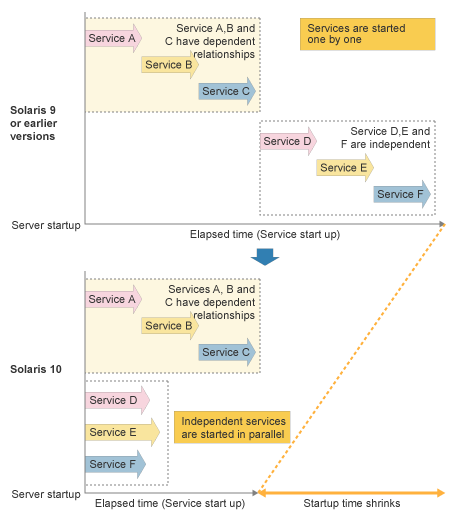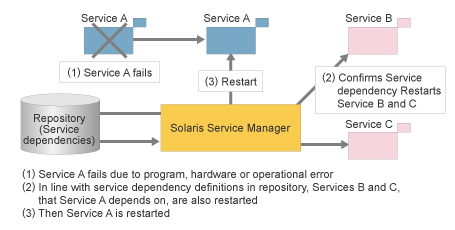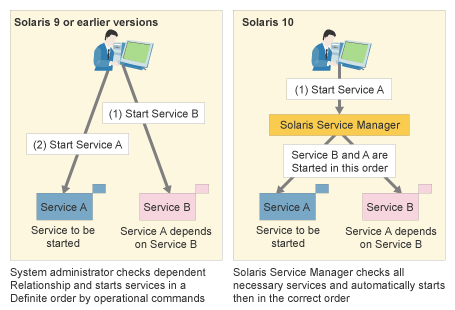Archived content
NOTE: this is an archived page and the content is likely to be out of date.
Solaris Service Manager of Solaris™ 10 Operating System function
Predictive Self-Healing : [ Solaris Service Manager | Solaris Fault Manager ]
This function unifies service control by managing the interdependency between services and their startup sequence
Solaris Service Manager unifies service control by managing the interdependency between services, ensuring that they are started (or restarted following service failure) in the appropriate order
The automation of startup and restart services leaves system administrators free to concentrate on other work.
Swift system startup
Solaris Service Manager shrinks service startup time by starting independent services in parallel.
With Solaris 9, services are started one by one following a service start script. This startup method is simple and adequate when handling small-scale systems.
However, with UNIX servers being used for more and more large-scale systems with many more services, it takes a long time to start them all in sequence.
Now with Solaris 10, non-dependent services are started in parallel based on a stored services relationship configuration. This new feature enables much quicker system startup and recovery, leading to greater business continuity and service availability.

Automatic service restarting
With Solaris 9 OS, service management required a detailed knowledge of services. If a service failed, the system administrator had to not only restart the failed service, but all other services that service depended on. Such careful operation had to be undertaken manually and required the administrator to have an intimate knowledge of the service dependencies.
With Solaris10, the system administrator no longer needs to know the interdependency of services. Solaris Service Manager holds the service interdependencies allowing it to automatically restart all necessary services without administrator intervention.
Solaris Service Manager constantly watches server status and automatically restarts any failed service.

Service management details
svcs(1) command
System administrators can more easily monitor services using Solaris Service Manager's service status information and service activation/deactivation interfaces based on the commands (svcs(1), svcadm(1) etc). Until Solaris 9, it was a complicated procedure to understand service status. Service level information was not provided and system administrators have to assume service status from their own analysis of kernel level information. A slow and error prone process.
svcadm(1M) command
Services and the services on which they depend are started in their appropriate order using the Solaris Service Manager svcadm(1) command. System administrators are longer required to run complicated service startup operations.
For example, if there are two services, Service A and Service B, and Service A depends on Service B, previously the system administrator needed to start the services paying close attention to their dependent relationship. Now with Solaris10, they only have to start Service A. Solaris Service Manager automatically detects that Service B needs to be started, and starts the services in the right sequence.

With Solaris 10 the traditional service stop procedure using the kill(1) or pkill(1) commands is no longer available. This is because, once stopped, Solaris Service Manager will automatically restart them. So a new command, svcadm (1M) is now used for stopping services.
| Solaris 9 or earlier versions | Solaris 10 | |
|---|---|---|
| Service status | ps(1) command
(only process information is shown) |
svcs(1) or ps(1) command |
| Service stop | # /etc/init.d/cron stop | # svcadm disable -t
system/cron:default |
| Service restart (temporary) | # /etc/init.d cron start | # svcadm enable -t
system/cron:default |
| Service stop
After service restart the service isn't started |
(1)# /etc/init.d/cron stop
(2)# mv /etc/rc2.d/S75cron /etc/rc2.d/_S75cron (Need to rename the service start script) |
# svcadm disable -t
system/cron:default |
| Service restart (permanent) | (1) # /etc/init.d/cron stop
(2) # /etc/init.d/cron start |
# svcadm restart -t
system/cron:default |


